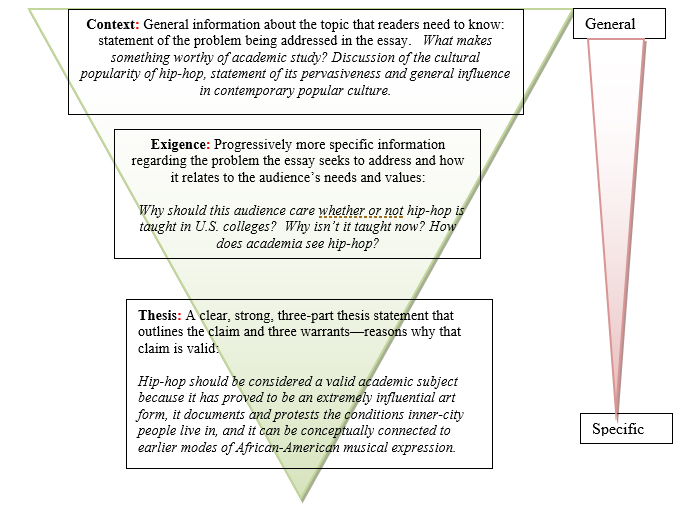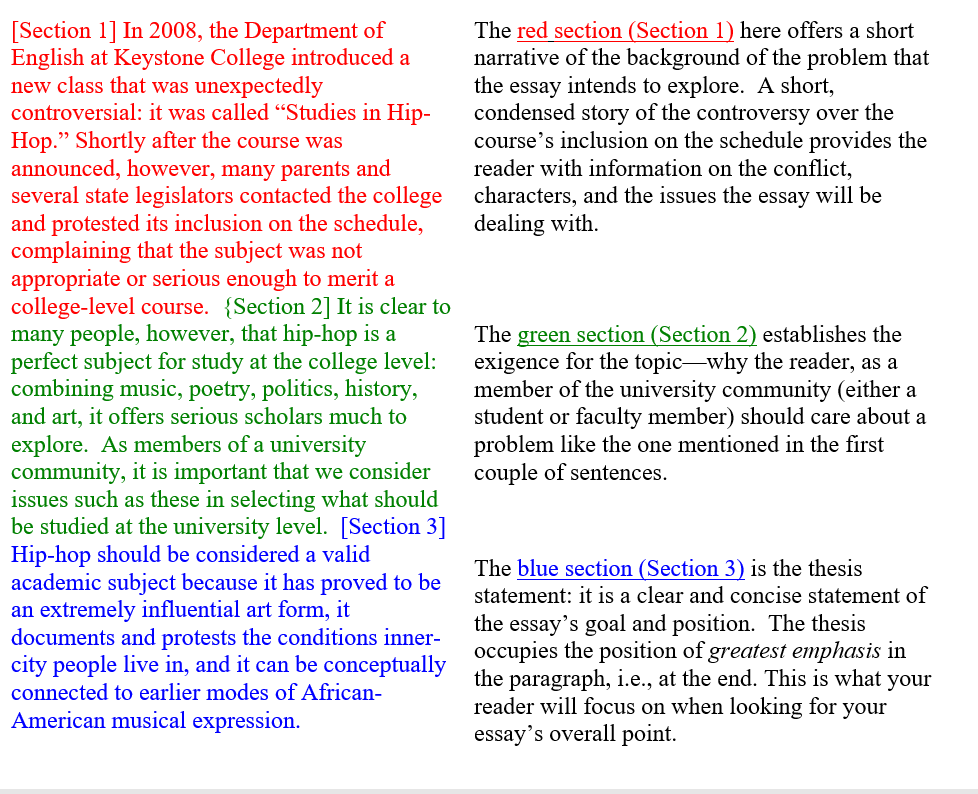Composition 06: Introductions
What are Introductions and Conclusions, and What Do They Do?
Have you ever wondered, when hearing one of your friends tell a story, “So what? What is this story about, and what on earth does this have to do with me?” If you ever had this thought, chances are your friend failed to make the relevance of the story clear to you when she started telling it: in short, she failed to introduce the story and establish a sense of importance for it.
In more formal writing, such as you are required to do in English 101, the overall subject and point of the writing, and this sense of importance and relevance—a concept called exigence—is established by a strong and clear introduction.
Conclusions often serve to remind the audience of the exigence of the writing, reviewing the overall points that were made in the writing and ensure that the audience understands the importance and relevance of the writing in their lives.
The Functions of an Introduction
Any effective introduction to a piece of writing must accomplish the following main tasks:
- Provide necessary background details on the subject of the writing
- Establish a sense of exigence and importance for the subject
- Contain and emphasize a clear and compelling thesis statement for the piece of writing
Function 1: Providing Necessary Background
One of the primary tasks of any introduction is to make it clear to the reader the essay’s topic, and what point of view will be used to approach that topic. This is perhaps the most straightforward and familiar task for any introduction: even the most basic, elementary-school level essays contain introductions that announce the topic. Consider the following:
There are many different types of trees native to Maryland. The beech, adler, birch, and Douglas fir are all present in various forests throughout the central and southern parts of the state. These are important natural resources and should be protected.
More advanced writing, however, requires more than a simple announcement of the topic: it should provide the audience with details that will enhance their understanding of that topic. Here’s a revision of the above paragraph, with added background information added to clarify the writer’s position on preserving native tree species in Maryland:
Over the past fifteen years, the major species of trees native to Maryland have been under threat. The beech, birch, adler, and Douglas fir, all of which are present in various forests throughout the central and southern parts of the state, are in danger of being eradicated by invasive tree and plant species, mainly from Asia and South America, such as the Purple Loosestrife and the Giant Hogweed. Because these native species are important natural resources for Marylanders, preserving them should be a high priority: these trees need to be protected.
Here the writer has selected and provided additional details for the reader: the types of native trees, their locations, the fact that they are under threat, and the source of the threat. The additional details help define the problem that the essay will address, namely the need for preservation of native Maryland trees.
Function 2: Establishing a Sense of Exigence
Exigence is the sense of importance and relevance that your audience gets for a piece of writing, the sense of urgency to think or act on a certain problem. In short, exigence answers the question “So What?” for the reader. Writing that lacks a sense of exigence may leave a reader feeling unfulfilled, or of having wasted his time reading the piece of writing.
Avoiding a Banal Topic
Establishing exigence is in part accomplished by selecting a good topic. The importance of a piece of writing like a process analysis or narrative of brushing one’s teeth or making a peanut butter and marshmallow sandwich is far more difficult to almost any audience due to its banal nature—subjects such as these are in general too common or “ordinary” to be truly compelling topics for a piece of writing that someone would actually want to read.
Exercise: Avoiding a Banal Topic
In the following list, identify the most compelling possible topic. Rate each on a scale from 1-10, with (1) being the most banal and (10) being the most compelling.
- A narrative essay telling the story of a young Italian immigrant overcoming ethnic discrimination in 1940s New York City. Rating ______
- A compare-contrast essay discussing the similarities and differences between onion bagels and sesame bagels. Rating ______
- A process analysis essay describing the best method of peeling a potato. Rating ______
- An argument essay advocating for the reform of health insurance regulations in Maryland. Rating ______
- An essay comparing and contrasting two different hairdos. Rating ______
- An essay telling the story of a party held off-campus last weekend. Rating ______
- A compare-contrast essay examining two different anti-poverty efforts in Washington, D.C. Rating ______
Exigence as an Urgent Problem
In addition to selecting a compelling and interesting topic, establishing a strong sense of “so what?” for your writing can be accomplished by reminding your audience of an urgent problem that they have, and positioning your writing as a solution to that problem. This, of course, requires that you have a sense of the audience to whom you are writing, the values they hold, and the problems that they face. See Chapter 07, Rhetorical Skills, for an extended discussion on audience and for specific ways of discovering this kind of information.
Advertisements, which are in essence very short arguments for an audience to take a specific action—purchasing a product—often make use of this strategy, reminding their audience of a recurring problem or need in their lives—physical, psychological, emotional, or material—and suggesting that their product can solve that problem. Consider the following print advertisements: what problem does their audience have, and how does this product position itself to solve that problem?



Function 3: Emphasizing a Clear and Compelling Thesis Statement
Chapter 05.3.1 discusses creating effective thesis statements. This section will discuss where those thesis statements should be located in the introduction to an essay in order to achieve the most clarity and emphasis.
As a general rule, thesis statements should occupy the position of greatest emphasis in the introductory paragraph—this usually means near the end, either the final or second-to-last sentence in the paragraph.
Introductions usually start with relatively general information about the problem to be addressed, build toward more narrow and specific information, and end with the essay’s thesis.
Here’s a sample thesis statement from the thesis chapter:
Hip-hop should be considered a valid academic subject because it has proved to be an extremely influential art form, it documents and protests the conditions inner-city people live in, and it can be conceptually connected to earlier modes of African-American musical expression.
The basic organizational pattern of an argumentative introduction might look like this diagram. General information and background in the first couple of sentences builds to more specific exigence-building and thesis information later on:

Consider the following example:

Continue to Composition 06a: Conclusions for more information on establishing exigence in writing.
